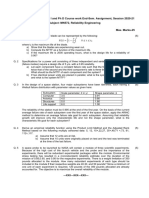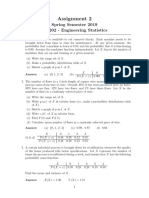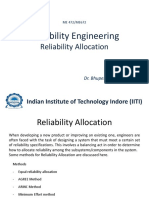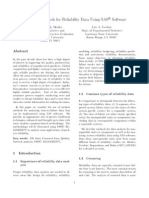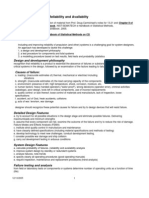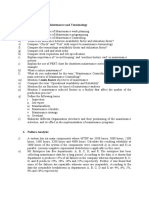Statistics Work
Statistics Work
Uploaded by
BrittanyWilliamsCopyright:
Available Formats
Statistics Work
Statistics Work
Uploaded by
BrittanyWilliamsOriginal Description:
Copyright
Available Formats
Share this document
Did you find this document useful?
Is this content inappropriate?
Copyright:
Available Formats
Statistics Work
Statistics Work
Uploaded by
BrittanyWilliamsCopyright:
Available Formats
Brittany Williams
INSY7300 Homework 1
29 August 2014
1.1. Suppose that you want to design an experiment to study the
proportion of unpopped kernels of popcorn. Complete steps 1-3 of
the guidelines for designing experiments. Are there any major
sources of variation that would be difficult to control?
1. Recognition of and statement of the problem. In a given sample,
how many kernels were
2. Selection of the response variable. The response variables would
the number of unpopped kernels and the total number of kernels in
a bag.
3. Choice of factors, levels, and ranges.
a. Factors and levels:
i. Cook time
1. 2 minutes
2. 3 minutes
ii. Brand
1. Act II
2. Orville
iii. Cook setting
1. High power (80%)
2. Low power (40%)
1.8. What is replication? Why do we need replication in an
experiment? Present an example that illustrates the difference
between replication and repeated measures.
Replication indicates an independent repeat run of each factor combination.
Replication allows the experimenter to obtain an estimate of the
experimental error and the true mean response for one of the experiments
factor levels.
You want to determine which soda combination is most refreshing: soda
(Mountain Dew, Coke, Sprite) and temperature (with or without ice).
Repeated measures experiment: Each respondent tries only coke with
ice and provides a refreshment rating. Next they try coke without ice
and provide a refreshment rating. This is repeated until each factor
combination has been tested.
Replication experiment: the respondent tries the 3 brands of soda with
ice and without ice, in random order, and provides a refreshment rating
for each combination. So the three sodas are treated in each
temperature setting, so there are three replicates obtained.
1.9. Why is randomization important in an experiment?
Randomization is important to mitigate the introduction of systematic bias
into the experimental results. Randomization also satisfies the requirement
that observations or errors are to be independently distributed random
variables.
1.10. What are the potential risks of a single large, comprehensive
experiment in contrast to a sequential approach?
In a single large, comprehensive experiment, it is assumed that you know the
objective and all of the important factors. However, if you do an initial
screening experiment, analyze that data, and continue to experiment based
off that information, you may have a better understanding of what the
important factors are, the impact of interaction effects, etc.
B. Describe how this course can help you in your work (or intended
future career).
I worked on a project to redesign an attribute of a medical device, so that the
device would meet specific Japanese design requirements. The body of the
device was to remain the same; only a single interior feature was to change. I
came up with four design options, and tested a number of variables to
determine the most optimized design. If I had already had this course, the
DOE would have been better approached! I plan to re-enter industry so
having a better understanding of DOE will definitely be beneficial for future
projects.
You might also like
- Essential Psychopathology and Its Treatment: by Jerrold S Maxmen Nicholas G Ward Mark D KilgusDocument3 pagesEssential Psychopathology and Its Treatment: by Jerrold S Maxmen Nicholas G Ward Mark D KilgusOverload4U0% (4)
- Productivity and Reliability-Based Maintenance Management, Second EditionFrom EverandProductivity and Reliability-Based Maintenance Management, Second EditionNo ratings yet
- Assignment 2 (Vishnubhai Jayeshbhai Panchal 202285861)Document8 pagesAssignment 2 (Vishnubhai Jayeshbhai Panchal 202285861)Ashish VoraNo ratings yet
- Assignment-MN572-Reliability EngineeringDocument1 pageAssignment-MN572-Reliability EngineeringArun Kumar100% (1)
- 6336 Lecture01Document27 pages6336 Lecture01Alican BodurNo ratings yet
- MM-Chapter 3-Replacement and Mauntenaance ModelsDocument8 pagesMM-Chapter 3-Replacement and Mauntenaance ModelsSouhaib K Al-Azzawi100% (1)
- Atpl - Exim Solution 2018Document23 pagesAtpl - Exim Solution 2018Mehul BazariaNo ratings yet
- A Data Engineer's Guide To Semantic Modelling - Ilaria MaresiDocument50 pagesA Data Engineer's Guide To Semantic Modelling - Ilaria Maresi1977amNo ratings yet
- Reliability and Maintainability in Operations ManagementDocument32 pagesReliability and Maintainability in Operations ManagementilublessingNo ratings yet
- Reliability Engineering LECTURE 2Document31 pagesReliability Engineering LECTURE 2Krishna PrasathNo ratings yet
- Note7 - Reliability - Theory - RevisedDocument5 pagesNote7 - Reliability - Theory - RevisedMohamed El KikiNo ratings yet
- Midterm Exam Plus Solutions Spring 2014Document6 pagesMidterm Exam Plus Solutions Spring 2014IsraelVictorNo ratings yet
- The Computational Complexity of Machine Learning - Michael J. Kearns PDFDocument176 pagesThe Computational Complexity of Machine Learning - Michael J. Kearns PDFDrHarman Preet SinghNo ratings yet
- Ch2 ReliabilitymanagementDocument57 pagesCh2 ReliabilitymanagementyitongcytNo ratings yet
- Reliability Engineering: Kartik Gupta 2K13/PE/016Document15 pagesReliability Engineering: Kartik Gupta 2K13/PE/016Kartik GuptaNo ratings yet
- Class 06 - Time Dependent Failure ModelsDocument37 pagesClass 06 - Time Dependent Failure Modelsosbertodiaz100% (1)
- Chapter - Five: Reliability, Availability and MaintainabilityDocument25 pagesChapter - Five: Reliability, Availability and MaintainabilityfekadeNo ratings yet
- Assignment 2 - Engineering Statistics - Spring 2019Document7 pagesAssignment 2 - Engineering Statistics - Spring 2019UBAID ULLAHNo ratings yet
- Simple Linear Regression and Correlation: Chapter OutlineDocument77 pagesSimple Linear Regression and Correlation: Chapter OutlineAídaMarianaNo ratings yet
- MetnumDocument25 pagesMetnumNissa OktaviaNo ratings yet
- UKFM QRMS 11EB02 Yuvanesan MuthukumaresanDocument27 pagesUKFM QRMS 11EB02 Yuvanesan MuthukumaresanYuvanesh Yuvan100% (1)
- Total Productive MaintenanceDocument3 pagesTotal Productive MaintenancebhnodarNo ratings yet
- 05W6 Ch04 Facilities Personnel RequirementsDocument42 pages05W6 Ch04 Facilities Personnel RequirementsMinh DuyNo ratings yet
- LOG211 - Lesson11 - SG - FINAL (v1.3) - 20121212 5000 - 02 W MarkupDocument72 pagesLOG211 - Lesson11 - SG - FINAL (v1.3) - 20121212 5000 - 02 W MarkupMichael AbeledaNo ratings yet
- Lecture Notes 3Document23 pagesLecture Notes 3Rifqi DarmawanNo ratings yet
- P. Balamurugan Deep Learning - Theory and PracticeDocument29 pagesP. Balamurugan Deep Learning - Theory and PracticeAnkit KumarNo ratings yet
- Reliability Allocation PDFDocument6 pagesReliability Allocation PDFDipankar Shrivastava100% (1)
- Pinnacle - Quantitative Reliability Optimization (QRO) Executive BriefDocument9 pagesPinnacle - Quantitative Reliability Optimization (QRO) Executive Briefmohamed al-amir100% (1)
- Applied Multivariate Analysis (Multivariate Analysis) DR Amit Mitra Iit KanpurDocument2 pagesApplied Multivariate Analysis (Multivariate Analysis) DR Amit Mitra Iit Kanpurwork0670% (1)
- Reliability Enginnering: Presented byDocument15 pagesReliability Enginnering: Presented byOmar Ahmed Elkhalil100% (1)
- Risk Analysis For Information and Systems Engineering: INSE 6320 - Week 3 Session 2Document23 pagesRisk Analysis For Information and Systems Engineering: INSE 6320 - Week 3 Session 2Deepika ManglaNo ratings yet
- Essential Cheat Sheets For Machine Learning and Deep Learning EngineersDocument16 pagesEssential Cheat Sheets For Machine Learning and Deep Learning EngineersVidyanand ThombareNo ratings yet
- Availability Prediction Methods - NASA PDFDocument6 pagesAvailability Prediction Methods - NASA PDFYassine MESSAOUDNo ratings yet
- Reliability Question PaperDocument2 pagesReliability Question PaperIshikaNo ratings yet
- Paper 262 Statistical Methods For Reliability Data Using SASR SoftwareDocument10 pagesPaper 262 Statistical Methods For Reliability Data Using SASR Softwaredshalev8694No ratings yet
- ReliabilityDocument58 pagesReliabilityGorvendra Singh100% (1)
- Chapter 3 Manufacturing Metrics and EconomicsDocument15 pagesChapter 3 Manufacturing Metrics and Economicstomocih624No ratings yet
- Design and Fabrication of Solar WheelchairDocument3 pagesDesign and Fabrication of Solar WheelchairInternational Journal of Innovative Science and Research TechnologyNo ratings yet
- IoT-Based Real-Time Monitoring and Control System For Distribution SubstationDocument6 pagesIoT-Based Real-Time Monitoring and Control System For Distribution Substationnagaraj.cNo ratings yet
- Reliability and AvailablityDocument6 pagesReliability and AvailablityFIRDAUS BIN MAHAMADNo ratings yet
- CH 10Document56 pagesCH 10Rommel Yan100% (1)
- Probabilistic Constrained Optimization Methodology and ApplicationsDocument350 pagesProbabilistic Constrained Optimization Methodology and ApplicationsGustavo Libotte100% (1)
- Reliability Engineering (Mec663)Document7 pagesReliability Engineering (Mec663)Arpit Goyal33% (3)
- Project Management: Topic: Network Diagram (Activity On Arrow)Document22 pagesProject Management: Topic: Network Diagram (Activity On Arrow)HAMZA ALINo ratings yet
- Maintenance and Reliability - Theory: John E. Skog P.E. WGA3-06 Tutorial June 2006 Rio de JaneiroDocument59 pagesMaintenance and Reliability - Theory: John E. Skog P.E. WGA3-06 Tutorial June 2006 Rio de JaneiroDXLopesNo ratings yet
- MG 443 Lesson 6 Maintenance StrategiesDocument27 pagesMG 443 Lesson 6 Maintenance StrategiesZegera Mgendi0% (1)
- Benefit Cost Ratio Analysis and Payback PeriodDocument20 pagesBenefit Cost Ratio Analysis and Payback Periodfadhillah ivanNo ratings yet
- Design and Analysis of ExperimentsDocument3 pagesDesign and Analysis of Experimentsapi-3723257No ratings yet
- Reliability Engineering LECTURE 4Document30 pagesReliability Engineering LECTURE 4Krishna PrasathNo ratings yet
- IE 443: Tutorial 1 1. Introduction To Maintenance and TerminologyDocument3 pagesIE 443: Tutorial 1 1. Introduction To Maintenance and Terminologyhamidu athumani100% (1)
- RCM XXXDocument11 pagesRCM XXXOmar KhaledNo ratings yet
- 2008 MuchiriDocument20 pages2008 MuchiriBushra AzharNo ratings yet
- CAD/CAM/CIMDocument59 pagesCAD/CAM/CIMNPMYS23No ratings yet
- Solutions Manual Ch13 - 2012Document37 pagesSolutions Manual Ch13 - 2012thegreatllNo ratings yet
- Reliability 2Document8 pagesReliability 2Georgina SuleNo ratings yet
- Maintenance Management IM - 503: - 6: Probability DistributionsDocument34 pagesMaintenance Management IM - 503: - 6: Probability DistributionsWasif AzimNo ratings yet
- A Statistical Process Control Case Study: Thomas K. Ross, PHDDocument16 pagesA Statistical Process Control Case Study: Thomas K. Ross, PHDRoberto OrtegaNo ratings yet
- 2 Marks Maintenance ManagementDocument2 pages2 Marks Maintenance ManagementRisath AhamedNo ratings yet
- ABC Hospital - SolutionDocument12 pagesABC Hospital - SolutionMayank Patel100% (1)
- Solution Midterm Exam - Engineering Statistics - 2018Document3 pagesSolution Midterm Exam - Engineering Statistics - 2018UBAID ULLAHNo ratings yet
- Human Factors For EngineersDocument389 pagesHuman Factors For EngineerspiolinwallsNo ratings yet
- Life Cycle Cost AnalysisDocument39 pagesLife Cycle Cost AnalysisJayaprakash SankaranNo ratings yet
- FCM YL1 LEC Community PlanningDocument120 pagesFCM YL1 LEC Community PlanningRuth Mary PadaNo ratings yet
- TelsmithT900 SpecSheetDocument2 pagesTelsmithT900 SpecSheetgugiNo ratings yet
- Flow and Mindfulness (1)Document18 pagesFlow and Mindfulness (1)PoulomiNo ratings yet
- A Procedure For Characterizing The Curing Process of Cold Recycled Bitumen Emulsion MixturesDocument9 pagesA Procedure For Characterizing The Curing Process of Cold Recycled Bitumen Emulsion MixturesharNo ratings yet
- Paid Internship Emeal Talent Organization - NTT Data VFDocument2 pagesPaid Internship Emeal Talent Organization - NTT Data VFmaximo.botellafNo ratings yet
- Secrecy Energy Efficiency in RIS-Assisted NetworksDocument6 pagesSecrecy Energy Efficiency in RIS-Assisted NetworksAamir HabibNo ratings yet
- Acdc Seminar 2 e PDFDocument56 pagesAcdc Seminar 2 e PDFNhân Nhậu NhẹtNo ratings yet
- Literature Review On Belt ConveyorDocument4 pagesLiterature Review On Belt Conveyordajev1budaz2100% (1)
- Keith Alexander Seffen - Solving Problems of Simple Structural Mechanics-Cambridge University Press (2022)Document203 pagesKeith Alexander Seffen - Solving Problems of Simple Structural Mechanics-Cambridge University Press (2022)udaykumar8995No ratings yet
- Jimmie MclaughlinDocument1 pageJimmie MclaughlinAmaliahAisyahRakhmiNo ratings yet
- C A Bangalore File 2Document9 pagesC A Bangalore File 2sadiq shaikhNo ratings yet
- Shenzhen Jiabaida Electronic Technology Co., LTD.: Specification SheetDocument29 pagesShenzhen Jiabaida Electronic Technology Co., LTD.: Specification SheetJakub TichýNo ratings yet
- Panel Resum 100w PDFDocument2 pagesPanel Resum 100w PDFCarlos TorresNo ratings yet
- Performance Test of A Shock AbsorberDocument3 pagesPerformance Test of A Shock AbsorberRaja SekaranNo ratings yet
- Rudder Main ReportDocument17 pagesRudder Main ReportLikhith Shetty HNo ratings yet
- Water Storage Tanks. (Overhead Water Tank, Underground Water Tank Etc)Document11 pagesWater Storage Tanks. (Overhead Water Tank, Underground Water Tank Etc)Naim Khan0% (1)
- Settlement Part ADocument5 pagesSettlement Part AHardik GajjarNo ratings yet
- Sample Question Paper - 5Document6 pagesSample Question Paper - 5first lastNo ratings yet
- Shiwoo Choi (SeanBonJovi) - Ball On Track Conclusions 24-25Document6 pagesShiwoo Choi (SeanBonJovi) - Ball On Track Conclusions 24-25shiwoo.choi2027No ratings yet
- SampleDocument1 pageSampleutthamcsCNo ratings yet
- Dominant Strategies: Prisoner's Dilemma HarmonyDocument23 pagesDominant Strategies: Prisoner's Dilemma HarmonyVictor ZahnNo ratings yet
- Gned 3 - Logic 1Document34 pagesGned 3 - Logic 1Aileen Dalian CristolesNo ratings yet
- A Business Proposal To Design A System For A Plywood ShopDocument38 pagesA Business Proposal To Design A System For A Plywood ShopsivaabhilashNo ratings yet
- Operating Manual M8162Document14 pagesOperating Manual M8162rafabustamante7651No ratings yet
- Speech Perception TRACE 1Document3 pagesSpeech Perception TRACE 1Kristelle MatiasNo ratings yet
- HFD ReportDocument193 pagesHFD ReportHouston Chronicle100% (1)
- CSC573Document41 pagesCSC573Syahmi AhmadNo ratings yet



